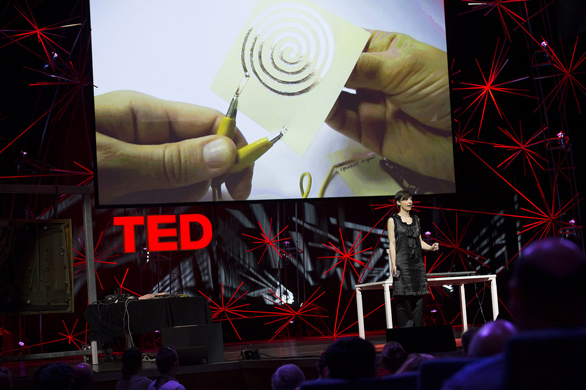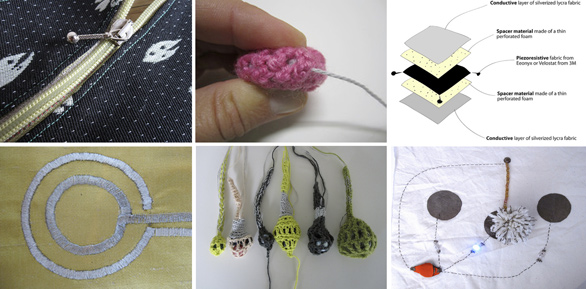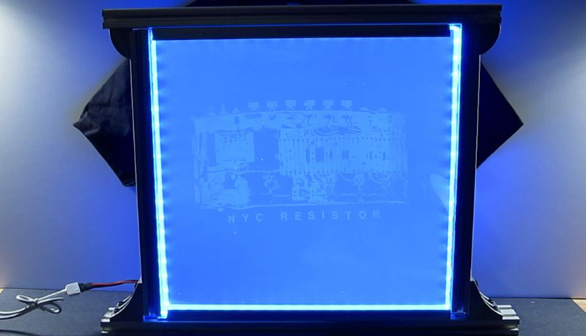 “We may not yet have the flying car that science fiction promised us,” says Catarina Mota in today’s talk, given at TEDGlobal 2012. “But we can have walls that change color depending on temperature, keyboards that roll up, and windows that become opaque at the flick of a switch.”
“We may not yet have the flying car that science fiction promised us,” says Catarina Mota in today’s talk, given at TEDGlobal 2012. “But we can have walls that change color depending on temperature, keyboards that roll up, and windows that become opaque at the flick of a switch.”
 Catarina Mota: Play with smart materials
As Mota demonstrates, smart materials will allow us to make some very cool things. But not a lot of information is currently out there about how these materials are made, how they work, and how they can be used. This is why Mota co-created OpenMaterials.org, a website for the sharing of experiments, information, tutorials and DIY projects involving smart materials.
Catarina Mota: Play with smart materials
As Mota demonstrates, smart materials will allow us to make some very cool things. But not a lot of information is currently out there about how these materials are made, how they work, and how they can be used. This is why Mota co-created OpenMaterials.org, a website for the sharing of experiments, information, tutorials and DIY projects involving smart materials.
“Innovation has always been fueled by tinkerers,” says Mota. “So many times, amateurs — not experts — have been the inventors and improvers of things like mountain bikes, personal computers, airplanes.”
To hear some examples of how makers volleying ideas can lead to innovation, watch this talk. And below, Mota shares some of the smart materials gaining momentum on her site.
Conductive Inks are paints infused with conductive particles like silver and carbon. They are used to create both hand-painted and printed electrical traces on paper, and are at the base of one of the most promising branches of material science: printed electronics. Printed electronics allow us to create cheap, flexible and recyclable circuits using standard paper, a slightly modified document printer and conductive ink. The types of conductive ink currently available outside university laboratories are still too resistive to replace copper and other conductors we use for traces. However, conductive ink is a good material for creating sensors in any shape we want — by simply painting them. In the video above, see some experiments I’ve been working on to create variable resistance sensors using only conductive ink, paper and basic electronic components like resistors and transistors.
Muscle Wire is a shape memory alloy that contracts between 3 and 7% when an electrical current runs through it. While this material is not strong enough for heavier applications — like rolling up heavy blinds or pulling any significant weight — it allows us to create motion in a noiseless and smooth way for a number of other applications in which the use of motors is not perfect. On the video above, I used muscle wire to make two small paper wings flap when a handmade paper switch is pushed.
Thermochromic Pigments change color at a given temperature. The two most common types of thermochromic materials are based on either leuco dies or liquid crystals. At specific temperatures the liquid crystals re-orientate to produce an apparent change of color. Thermochromic materials can be triggered by body heat or used in conjunction with heating elements such as nichrome, steel thread or even simply conductive thread. Think: a baby’s bottle that changes color when the milk is cool enough to drink.

Electrotextiles include thread, fabrics and yarn with electrical properties. They are made by blending or coating textiles with metallic fibers and are available in many different weaves and textures. We’re only just discovering uses for these materials — but some of the most interesting, in my opinion, are for making a large array of sensors like the ones developed by Kobakant and pictured above: a zipper slider, a crochet squeeze sensor, a piezoresistive touch pad, an embroidered potentiometer, a knit accelerometer, and a tilt sensor. Conductive fabrics have also been used both by hobbyists and product designers to make objects like roll-up keyboards, jackets with controls for smart phones and electronics-enhanced garments.

Light Diffusing Acrylic is infused with colorless light diffusing particles. While regular acrylic only diffuses light around the edges, this material illuminates across its entire surface. On the example pictured above, we wrapped a strip of RGB LEDs around a piece of this material and made it cycle through several colors to demonstrate its light diffusing properties. Light diffusing acrylics are currently used for interior design and multi-touch applications.
Also, check out the Lotus Dome — an incredible installation built out of hundreds of “smart metals.” It comes highly recommended by TED’s Director of Design Services, Mike Femia.
Comments (9)
Pingback: Design Domain (Dream On!) | Karolina Kaucka - Interaction Design - Glasgow School of Art
Pingback: Desenhando circuitos eletrônicos | Eduardo Veríssimo
Pingback: 你也能 DIY 智慧型材料(Smart Materials)! | TEDxTaipei
Pingback: If you want to build the future, you need to understand smart materials | Attendly
Pingback: Open Source Smart Materials Will Change the Entire World | The S.P.A.C.E Program